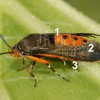 Squash vine borer is a moth species that is active during the day (diurnal). The larvae complete their growth and development on wild and domesticated species of the genus Cucurbita. Once only considered a nuisance to commercial growers, with the expansion of cucurbit production in the United States over the last decade, the squash vine borer has become a pest of economic importance. This 5-page fact sheet was written by Eutychus Kariuki and Jennifer L. Gillett-Kaufman, and published by the UF Department of Entomology and Nematology, December 2014. (Photo: Lyle J. Buss, UF/IFAS)
Squash vine borer is a moth species that is active during the day (diurnal). The larvae complete their growth and development on wild and domesticated species of the genus Cucurbita. Once only considered a nuisance to commercial growers, with the expansion of cucurbit production in the United States over the last decade, the squash vine borer has become a pest of economic importance. This 5-page fact sheet was written by Eutychus Kariuki and Jennifer L. Gillett-Kaufman, and published by the UF Department of Entomology and Nematology, December 2014. (Photo: Lyle J. Buss, UF/IFAS)
http://edis.ifas.ufl.edu/in1068
Tag: Cucurbit Pest Insects
South American Cucurbit Fruit Fly, Anastrepha grandis (Macquart) (Insecta: Diptera: Tephritidae) (EENY205/IN362)
 This rather large, yellow-brown, fruit fly with yellow and dark-brown markings exists in several South American countries, and attacks watermelon and other fruits of the family Cucurbitaceae. Once a pest of minor to moderate importance generally, it has become a rather important pest. The pest status differs in each country and has sometimes changed within a country . This species is potentially of economic importance in Florida and southern Texas should it ever be introduced there. It has been intercepted in the United States in pumpkin from Argentina and Brazil, and in banana debris from Panama.This 3-page fact sheet was written by H. V. Weems, Jr., and published by the UF Department of Entomology and Nematology, March 2012.
This rather large, yellow-brown, fruit fly with yellow and dark-brown markings exists in several South American countries, and attacks watermelon and other fruits of the family Cucurbitaceae. Once a pest of minor to moderate importance generally, it has become a rather important pest. The pest status differs in each country and has sometimes changed within a country . This species is potentially of economic importance in Florida and southern Texas should it ever be introduced there. It has been intercepted in the United States in pumpkin from Argentina and Brazil, and in banana debris from Panama.This 3-page fact sheet was written by H. V. Weems, Jr., and published by the UF Department of Entomology and Nematology, March 2012.
http://edis.ifas.ufl.edu/in362
EENY375/IN678 Fuller Rose Beetle, Naupactus godmanni (Crotch) (Insecta:Coleoptera: Curculionidae)
Revised! EENY-375, a 5-page illustrated fact sheet by Jamba Gyeltshen and Amanda Hodges, is part of the Featured Creatures collection. It describes this cosmopolitan beetle whose extensive list of hosts include citrus, cucurbits, strawberry, beans, peach, rhubarb, rose, and potato — synonymy, distribution, description, biology, host plants, damage, and management. Includes references. Published by the UF Department of Entomology and Nematology, June 2009.
http://edis.ifas.ufl.edu/IN678